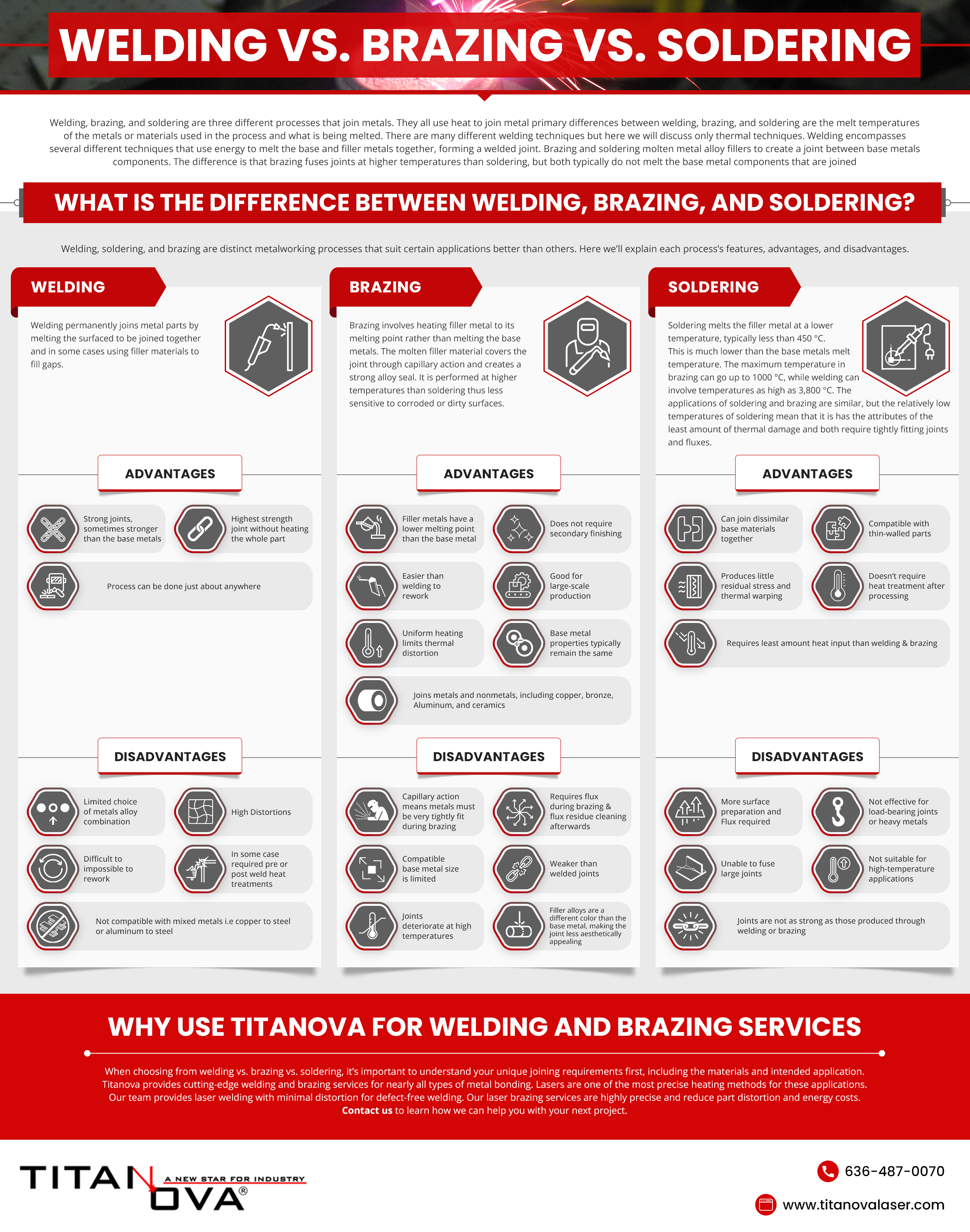Welding, brazing, and soldering are three different processes that join metals. They all use heat to join metal primary differences between welding, brazing, and soldering are the melt temperatures of the metals or materials used in the process and what is being melted. There are many different welding techniques but here we will discuss only thermal techniques. Welding encompasses several different techniques that use energy to melt the base and filler metals together, forming a welded joint. Brazing and soldering molten metal alloy fillers to create a joint between base metals components. The difference is that brazing fuses joints at higher temperatures than soldering, but both typically do not melt the base metal components that are joined
Welding, brazing, and soldering each have advantages and disadvantages for certain applications. Find out more about their distinct characteristics here.
What Is the Difference Between Welding, Brazing, and Soldering?
Welding, soldering, and brazing are distinct metalworking processes that suit certain applications better than others. Here we’ll explain each process’s features, advantages, and disadvantages.
Welding
Welding permanently joins metal parts by melting the surfaced to be joined together and in some cases using filler materials to fill gaps.
Advantages of welding include:
- strong joints, sometimes stronger than the base metals
- highest strength joint without heating the whole part
- process can be done just about anywhere
Disadvantages of welding include:
- Limited choice of metals alloy combination
- High distortions
- Difficult to impossible to rework
- Not compatible with mixed metals i.e copper to steel or aluminum to steel
- In some case required pre or post weld heat treatments
Brazing
Brazing involves heating filler metal to its melting point rather than melting the base metals. The molten filler material covers the joint through capillary action and creates a strong alloy seal. It is higher than soldering thus less sensitive to corroded or dirty surfaces.
Advantages of brazing include:
- Filler metals have a lower melting point than the base metal
- Joins metals and nonmetals, including copper, bronze, Aluminum, and ceramics
- Does not require secondary finishing
- Easier than welding to rework
- Good for large-scale production
- Uniform heating limits thermal distortion
- Base metal properties typically remain the same
Disadvantages of brazing are:
- Capillary action means metals must be very tightly fit during brazing
- Requires flux during brazing and flux residue cleaning afterwards
- Compatible base metal size is limited
- Filler alloys are a different color than the base metal, making the joint less aesthetically appealing
- Weaker than welded joints
- Joints deteriorate at high temperatures
Soldering
Soldering melts the filler metal at a lower temperature, typically less than 450 °C. This is much lower than the base metals melt temperature. The maximum temperature in brazing can go up to 1000 °C, while welding can involve temperatures as high as 3,800 °C. The applications of soldering and brazing are similar, but the relatively low temperatures of soldering mean that it is has the attributes of the least amount of thermal damage and both require tightly fitting joints and fluxes.
Advantages of soldering include:
- Requires least amount heat input than welding and brazing
- Can join dissimilar base materials together
- Compatible with thin-walled parts
- Produces little residual stress and thermal warping
- Doesn’t require heat treatment after processing
Disadvantages of soldering include:
- More surface preparation and Flux required
- Joints are not as strong as those produced through welding or brazing
- Not effective for load-bearing joints or heavy metals
- Unable to fuse large joints
- Not suitable for high-temperature applications
Why Use Titanova for Welding and Brazing Services
When choosing from welding vs. brazing vs. soldering, it’s important to understand your unique joining requirements first, including the materials and intended application. Titanova provides cutting-edge welding and brazing services for nearly all types of metal bonding. Lasers are one of the most precise heating methods for these applications. Our team provides laser welding with minimal distortion for defect-free welding. Our laser brazing services are highly precise and reduce part distortion and energy costs. Contact us to learn how we can help you with your next project.

